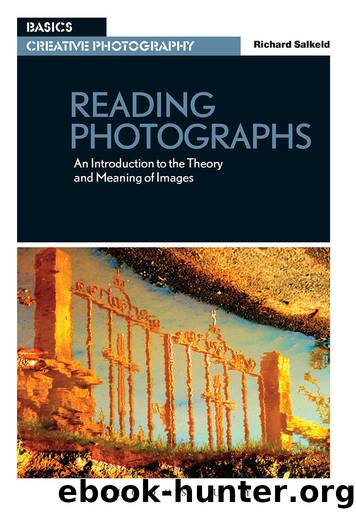Reading Photographs: An Introduction to the Theory and Meaning of Images (Basics Creative Photography) by Richard Salkeld

Author:Richard Salkeld [Salkeld, Richard]
Language: eng
Format: azw3
ISBN: 9781350034044
Publisher: Bloomsbury Publishing
Published: 2017-10-05T04:00:00+00:00
4.3
Title: Tattooed
Photographer: Kenneth Benjamin Reed
Practices of body decoration and modification have ancient histories and traditions rooted in ritual; however, contemporary Western applications may be more concerned with individualism. Whether this signifies the expression of a unique ‘essential’ identity, or is evidence of the construction of an identity, remains a matter for debate.
What is identity?
The notion of individual identity is quite slippery. Where and what is it? Does it derive from your genes, from where you were born, from your race, class or education, your gender or sexuality? Or from what you look like? The colour of your skin, the colour of your hair, or eyes, or even the clothes you wear? Of course, it is all these things – together with the story of your life, your experiences and circumstances.
Nevertheless, conventional thinking proposes that whatever our situation, whatever poses we might strike, whatever fashions and styles we may affect, inside us there is our ‘real’ and ‘true’ identity; an individual essence which marks us from the cradle to the grave and which the skilled portraitist might strive to recognise, capture and represent.
This is an essentialist notion of identity, which assumes that such an essence defines us and is unchanging. While it is clear that we are all the products of our unique genetic inheritance which defines certain physical attributes, this doesn’t quite satisfy the idea of ‘character’; it might be argued that our character is intrinsic to our nationality, gender, sexuality, class, ethnicity, even faith. But this is problematic: nationality, for example, is an entirely political notion, and interpretations of the meanings of gender, sexuality, class, ethnicity and faith vary widely.
Constructed identity
An alternative approach, and one which reflects the ideas discussed in chapters 2 and 3, is the ‘constructivist’ notion of identity. Just as it was proposed that ‘things’ only have meaning in virtue of their context – the way they are seen in relation to other things, how they are used, what they are called – so, too, it can be argued that identity is not fixed but is relational. Who we are derives from the circumstances of environment, but needn’t define us; who we appear to be depends upon how we present ourselves and to whom.
In short, our identity is an on-going (life-long) constructive project, and how we are perceived depends upon the interaction between our performance and the mastery of the conventions of signifiers of identity and the skills with which they are read.
Download
This site does not store any files on its server. We only index and link to content provided by other sites. Please contact the content providers to delete copyright contents if any and email us, we'll remove relevant links or contents immediately.
Shoot Sexy by Ryan Armbrust(17564)
Portrait Mastery in Black & White: Learn the Signature Style of a Legendary Photographer by Tim Kelly(16877)
Adobe Camera Raw For Digital Photographers Only by Rob Sheppard(16805)
Photographically Speaking: A Deeper Look at Creating Stronger Images (Eva Spring's Library) by David duChemin(16505)
Bombshells: Glamour Girls of a Lifetime by Sullivan Steve(13703)
Art Nude Photography Explained: How to Photograph and Understand Great Art Nude Images by Simon Walden(12858)
Perfect Rhythm by Jae(5080)
Pillow Thoughts by Courtney Peppernell(4032)
The Book of Joy by Dalai Lama(3711)
Good by S. Walden(3360)
The Pixar Touch by David A. Price(3225)
A Dictionary of Sociology by Unknown(2864)
Fantastic Beasts: The Crimes of Grindelwald by J. K. Rowling(2853)
Stacked Decks by The Rotenberg Collection(2699)
Humans of New York by Brandon Stanton(2694)
Read This If You Want to Take Great Photographs by Carroll Henry(2609)
On Photography by Susan Sontag(2494)
Photographic Guide to the Birds of Indonesia by Strange Morten;(2412)
Insomniac City by Bill Hayes(2404)
